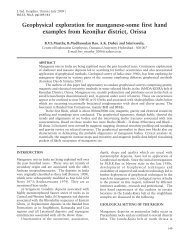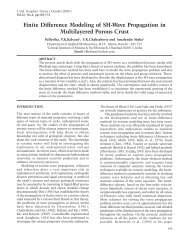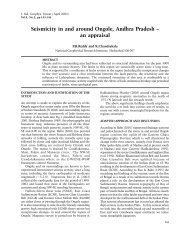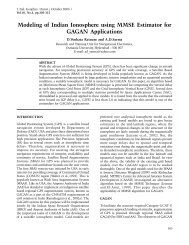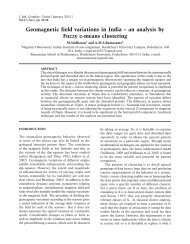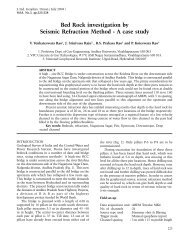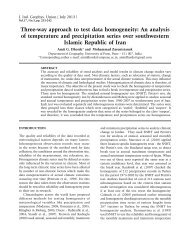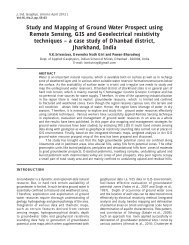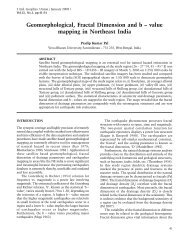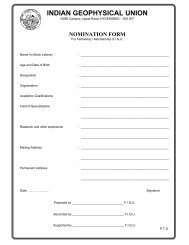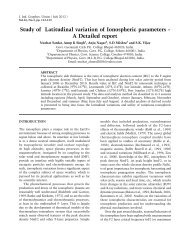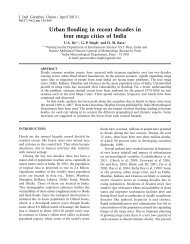What to trust in a Magnetotelluric Model? - IGU
What to trust in a Magnetotelluric Model? - IGU
What to trust in a Magnetotelluric Model? - IGU
Create successful ePaper yourself
Turn your PDF publications into a flip-book with our unique Google optimized e-Paper software.
K.K.Roy et al.features <strong>in</strong> all the models with different geometricalshapes should be accepted with greater level ofconfidence. M<strong>in</strong>or features which are not common <strong>in</strong>TE, TM and TE+TM mode models should preferablybe ignored or attached some weightage after crossverification from other auxiliary geophysical orgeological <strong>to</strong>ols.b) From model experiment it has been shown veryclearly that for vertical <strong>in</strong>homogeneities, viz., grabens,dykes, etc., TM mode MT anomalies are much moresharper than TE mode MT anomalies. Therefore,greater weightage can be attached <strong>to</strong> the TM modemodels for mapp<strong>in</strong>g shear zones, suture zones, faults,fractures, l<strong>in</strong>eaments, etc.c) Rotation <strong>in</strong>variant apparent resistivities and theirphases are very close <strong>to</strong> each other. Moreover, the<strong>in</strong>formation content will be more <strong>in</strong> (ρ D,φ D), (ρ C,φ C)and (ρ B,φ B) pairs. Therefore, models generated fromrotation <strong>in</strong>variant parameters will be very close andmore <strong>trust</strong>worthy. For 1D and 3D problems we canuse these pairs as such for model<strong>in</strong>g. For 2D we have<strong>to</strong> make 2D stiched <strong>in</strong> models from 1D-<strong>in</strong>vertedmodels because TE and TM mode electromagneticwave equations cannot be used for rotation <strong>in</strong>variantparameters. <strong>Model</strong>s generated us<strong>in</strong>g RITs and TE modeof RRI are presented just <strong>to</strong> show the readers how dothey look like.d) Rout<strong>in</strong>e do’s and don’ts <strong>in</strong> MT, which are wellknown <strong>to</strong> the MT community, must be followedreligiously <strong>to</strong> improve the <strong>trust</strong>worth<strong>in</strong>ess of themodels. These guidel<strong>in</strong>es are (i) avoid cultural noiseas far as practicable (ii) avoid solar quiet days as faras practicable for field measurements (iii) summermonths are preferable for MT field data acquisition(iv) for deeper prob<strong>in</strong>g, hard rock terra<strong>in</strong> should bechosen so that high frequency MT signals also canpenetrate <strong>to</strong> a considerable depth.e) For <strong>in</strong>terpretation of MT data collected over anArchaean or Proterozoic terra<strong>in</strong>, if we go for 1D<strong>in</strong>version, we should over parameterize the models <strong>to</strong><strong>in</strong>crease the <strong>trust</strong>worth<strong>in</strong>ess of the models. 3 <strong>to</strong> 4layered earth model for a granite batholith or ahighgrade granulitic terra<strong>in</strong> is not acceptable <strong>to</strong> thegeologists. For 2 dimensional <strong>in</strong>terpretation if wechoose square or rectangular blocks of bigger size <strong>in</strong>f<strong>in</strong>ite difference or f<strong>in</strong>ite element forward models,square elements or blocks of different colors appear<strong>in</strong> the 2D models. Geologists are reluctant <strong>to</strong> acceptthe square blocks <strong>in</strong> the models. Either very f<strong>in</strong>e f<strong>in</strong>itedifference cells should be taken with some <strong>in</strong>crease<strong>in</strong> computation time or f<strong>in</strong>ite element method withisoparametric elements should be chosen <strong>to</strong> map thecomplicated subsurface geology.ACKNOWLEDGEMENTSAuthors are grateful <strong>to</strong> DST for sanction<strong>in</strong>g theproject ESS/16/103/98. Thanks are due <strong>to</strong> the Direc<strong>to</strong>rGeneral of the Geological Survey of India for provid<strong>in</strong>g<strong>in</strong>frastructural facilities for carry<strong>in</strong>g out fieldwork nearKhandwa, Madhya Pradesh. Thanks are due <strong>to</strong> Mackiefor provid<strong>in</strong>g us their softwares for model experiment.Thanks are due <strong>to</strong> Mr.S.P.Hazra of IIT, Kharagpur fordraft<strong>in</strong>g the diagrams nicely. Thanks are due <strong>to</strong> JohnBooker for allow<strong>in</strong>g us <strong>to</strong> work with their softwares.REFERENCESBachus,G.E.& Gilbert, F., 1967. NumericalApplication of formalism for geophysical <strong>in</strong>verseproblems, Geophys. J.R. Astr. Soc., 13, 247-276.Berdichevskii, M.N. & Dmitriev, V.I.,1976. Basicpr<strong>in</strong>ciples of <strong>in</strong>terpretation of magne<strong>to</strong>telluriccurves <strong>in</strong> geoelectric and geothermal studies,KAPG geophysical monograph, pp.165-221, ed.Adam, A., Academic Kiado, Budapest.D’ Erceville, L. & Kunetz, G., 1962. The effect of afault on the earth’s natural electromagnetic Field,Geophysics, 27, 666-676.Eggers, D.E.,1982. An eigen state formulation of themagne<strong>to</strong>telluric impedance tensor, Geophysics,47,1204-1214.Lilley, F.E.M., 1993. Magne<strong>to</strong>telluric analysis us<strong>in</strong>gMohr Circle. Geophysics, 58, 1498-1506.Mackie,R.L., Madden,T.R. & Wannamaker,T.E., 1993,Three Dimensional Magne<strong>to</strong>telluric <strong>Model</strong>l<strong>in</strong>gus<strong>in</strong>g difference equations-Theory andComparison <strong>to</strong> Integral Equation Solution,Geophysics, 58, 215-226.Rank<strong>in</strong>, D., 1962. The magne<strong>to</strong>telluric effect on aDike, Geophysics, 27, 651-665.Roy, K. K., S<strong>in</strong>gh, A. K. & Rao, C. K., 1998a. Twodimensional Magne<strong>to</strong>telluric model of theS<strong>in</strong>ghbhum granite batholith. <strong>in</strong> DeepElectromagnetic Exploration, pp.120.-151, Eds.Roy, K.K., Verma, S.K. & Mallick, K., Spr<strong>in</strong>gerVerlag, Germany.Roy, K. K., Srivastava, S. & S<strong>in</strong>gh, A. K., 1998b.Rotation <strong>in</strong>variant magne<strong>to</strong>telluric impedancetensor: a case study from West S<strong>in</strong>ghbhum,Bihar, <strong>in</strong> Deep Electromagnetic Exploration, pp.99-119, Eds. Roy, K.K., Verma, S.K. & Mallick,K., Spr<strong>in</strong>ger Verlag, Germany.Roy, K.K., Das, L. K., Mukherjee, K. K. & Naskar,D. C.,1996. Some upper crustal <strong>in</strong>formation ofthe S<strong>in</strong>ghbhum cra<strong>to</strong>n based on direct currentgeoelectric survey. Indian Journal of Geology170



